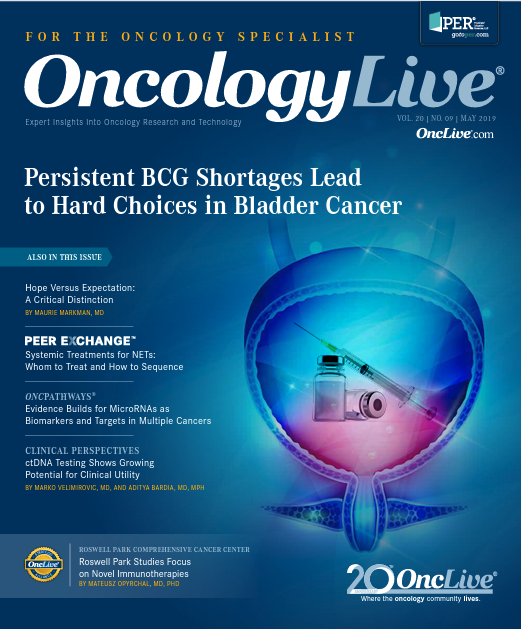Publication
Article
Oncology Live®
Habits of Young Adults Threaten to Reverse Cancer Progress
Author(s):
Smoking and obesity rates are rising rapidly among middle school and high school students, and these trends may undo the progress made against tobacco- and obesity-related cancers in adults.
Smoking and obesity rates are rising rapidly among middle school and high school students, and these trends may undo the progress made against tobacco- and obesity-related cancers in adults, according to reports from the Centers for Disease Control (CDC) and the Trust for America’s Health in collaboration with the Robert Wood Johnson Foundation.1,2
Figure 1. Estimated Prevalence of Tobacco Products Used By High School Students—2018
Figure 2. Estimated Prevalence of Tobacco Products Used By Middle School Students—2018
The CDC’s National Youth Tobacco Survey results indicated that in 2018, 27.1% of high school students (4.04 million) and 7.2% of middle school students (840,000) used tobacco products (Figures 1 and 2).
Figure 3. Tobacco Product Use Among High School Students—2018
Electronic cigarettes (e-cigarettes) topped the list—they were used by 20.8% of high schoolers (3.05 million) and 4.9% of middle schoolers (570,000). Increasing use of e-cigarettes among US youths, coupled with no change in use of other tobacco products from 2017 to 2018, eclipsed recent progress in reducing overall tobacco product use in this population, the CDC reported, describing the growing attachment to e-cigarettes as an “epidemic”1 (Figure 3).
“Approximately 1.5 million more youths…used e-cigarettes in 2018 (3.6 million) compared with 2017 (2.1 million),” the report stated.
Findings from the annual survey showed that from 2017 to 2018 e-cigarette use among high school and middle school students increased 38.5%.1 The results indicated that 42.0% of high schoolers and 42.7% of middle schoolers who used tobacco products in 2018 used e-cigarettes exclusively.
The report said that e-cigarettes are on the rise due to an increase in the sales of Juul, a USB-shaped device with a high nicotine content that can be used discreetly and is available in flavors such as mint and mango that appeal to youths. Introduced in 2015, Juul was the most commonly used e-cigarette product by December 2017. A single prefilled liquid nicotine pod contains as much nicotine as a pack of cigarettes.1
In March 2019, the FDA released a draft compliance policy aimed at limiting the distribution of flavored e-cigarette and cigar products, with a special focus on preventing youth access. “We cannot allow a generation of children to become addicted to nicotine through e-cigarettes,” said Scott Gottlieb, MD, former commissioner of the FDA, in a statement. “If the 2019 National Youth Tobacco Survey continues to show sharp increases in youth use of tobacco products, the FDA will consider additional measures to address this crisis.”3
Figure 4. Percentage of High School Students With Obesity—1970-2016
Figure 5. Percentage of High School Students With Obesity, By Demographic Group—2015-2016
Similar concerns regarding trends in youth arose in obesity trends of high school aged students in the United States. Between 1980 and 2016, obesity rates among teenagers aged 12 to 19 years quadrupled, going from 5% to 20.6%, according to the National Health and Nutrition Examination Survey, which was cited in the 2018 State of Obesity Report compiled by the Trust for America’s Health and Robert Wood Johnson Foundation. Authors collected data from the most recently available surveys to provide a fuller picture of the historical impact and trend of obesity among the United States’ youth (Figures 4 and 5).2
The Youth Risk Behavior Survey results indicated that in 2017, 14.8% of high school students nationwide had obesity and 15.6% were reported overweight—a contrast from 2015, when the respective rates were 13.9% and 16.0%. Among children aged 10 to 17 years, 16.1% were obese and 15.0% were overweight, according to the 2016 National Survey of Children’s Health.2
The prevalence of obesity and severe obesity increases with age, which affects the prevalence of obesity-related diseases. Without intervention, more than half of today’s children will be obese by age 35, according to “The State of Obesity”, an annual report.2
A 2019 study reported that from 1995 to 2014, the incidence of 6 of 12 obesity-related cancers (including multiple myeloma, colorectal, uterine corpus, gallbladder, kidney, and pancreatic) rose significantly among adults aged 25 to 49.4 Younger generations are experiencing longer-lasting exposure to excess fat and obesity-related health conditions, according to Ahmedin Jemal, DVM, PhD, a co-author of the study. 
References
- Gentzke AS, Creamer M, Cullen KA, et al. Vital signs: tobacco product use among middle and high school students - United States, 2011—2018. MMWR Morb Mortal Wkly Rep. 2019;68(6):157164. doi: 10.15585/mmwr.mm6806e1.
- Warren M, Beck S, Rayburn J. The state of obesity: better policies for a healthier America 2018. media.stateofobesity.org/wp-content/uploads/2019/02/19162010/stateofobesity2018.pdf. Published September 2018. Accessed March 14, 2019.
- Statement from FDA Commissioner Scott Gottlieb, M.D., on advancing new policies aimed at preventing youth access to, and appeal of, flavored tobacco products, including e-cigarettes and cigars [press release]. Silver Spring, MD: FDA; March 13, 2019. www.fda.gov/NewsEvents/Newsroom/PressAnnouncements/ucm633291.htm. Accessed March 14, 2019.
- Sung H, Siegel RL, Rosenberg PS, Jemal A. Emerging cancer trends among young adults in the USA: analysis of a population-based registry [published online February 4, 2019]. Lancet Public Health. doi: 10.1016/S2468-2667(18)30267-6.


























%20(2)%201-Recovered-Recovered-Recovered-Recovered-Recovered-Recovered-Recovered-Recovered-Recovered-Recovered-Recovered-Recovered-Recovered-Recovered-Recovered-Recovered-Recovered.jpg?fit=crop&auto=format)
%20(2)%201-Recovered-Recovered-Recovered-Recovered-Recovered-Recovered-Recovered-Recovered-Recovered-Recovered-Recovered-Recovered-Recovered-Recovered-Recovered-Recovered-Recovered.jpg?fit=crop&auto=format)
